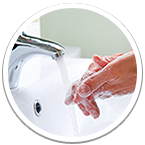Surveillance of healthcare-associated infections
A healthcare-associated infection is an infection that
- occurs during treatment or care provided in a healthcare or social welfare unit, or
- is associated with procedures carried out in these units.
Approximately 100,000 treatment-related infections occur in Finland each year, one half of them in hospitals and the other half in long-term care.
Healthcare-associated infections
On this page
Finnish Hospital Infection Programme SIRO
Healthcare-associated infections are monitored nationally in Finland as part of the Finnish Hospital Infection Programme (SIRO), which has been operating since 1999.
The SIRO programme currently involves all Finnish university hospitals and some other hospitals. The programme monitors healthcare-associated infections with significance for public health.
The SIRO programme helps hospitals prevent healthcare-associated infections. It improves the monitoring of infections and collects data on their occurrence in participating hospitals. The hospitals participating in the programme can compare their prevalence figures with those of other hospitals.
In the SIRO programme, hospitals are represented by persons from different professional groups who are responsible for infection control in practice: infection control nurses, communicable disease control physicians, clinical microbiologists, hospital microbiologists and surgeons.
Objectives of the programme
- prevention of healthcare-associated infections
- development of surveillance and feedback associated with it
- common definitions and surveillance methods
- prevalence figures for hospital use
- common prevention guidelines and recommendations
- investigations of hospital outbreaks
- training and courses
- research.
Infections to be monitored and studies
1. Nosocomial bloodstream infections
- from September 1998
- includes all hospital wards
- laboratory based case-finding by infection control nurses
- rate per ward and specialisation
- patient groups and predisposing factors, including central venous catheters
- causative pathogens and their susceptibility to antimicrobials
2. Surgical site infections
- from January 1999: coronary surgery, hip and knee prosthesis, and upper femur fractures
- from January 2003: caesarean section, breast surgery, appendectomy and hysterectomy
- from 2008: laminectomy and spinal fusion surgery
- rate by procedure and risk category
- causative pathogens and their antimicrobial resistance
3. Prevalence studies
- cross-sectional study on the prevalence of healthcare-associated infections at a given moment in a sample of Finnish hospitals
- in 2005, all somatic specialities except paediatrics (30 hospitals)
- in 2008–2009, repeated studies in all neonatal intensive care and control units (24 units)
- in 2011, a European prevalence study (59 hospitals)
- in 2016, a European prevalence study (50 hospitals)
- in 2017, a European prevalence study at long-term care facilities (175 operating units)
4. Clostridium difficile infections
- from September 2008
- all hospital wards
- laboratory based case-finding by infection control nurses
- overall incidence, nosocomial incidence and prevalence at admission
- severe cases and outbreaks
5. Resource survey, or a survey on prevention
- A survey on methods used to monitor and control healthcare-associated infections in acute hospitals and the number of infection control experts
- annually since 2018
- previous surveys in 2000, 2008 and 2015
Publications on healthcare-associated infections
- Maija Rummukainen / Antimicrobial use and infections in Finnish long-term care facilities (2013)
- Eira Poikonen / Epidemiology of Candidemia in Finland (2011)
- Emmi Sarvikivi / Healthcare-Associated Infections in Pediatrics (2008)
- Kaisa Huotari / Surveillance of surgical site infections after orthopedic surgery (2007)
- Anne-Marie Kerttula / Methicillin-resistant Staphylococcus aureus in Finland: recent changes in the epidemiology, long-term facility aspects, and phenotypic and molecular detection of isolates (2007)




